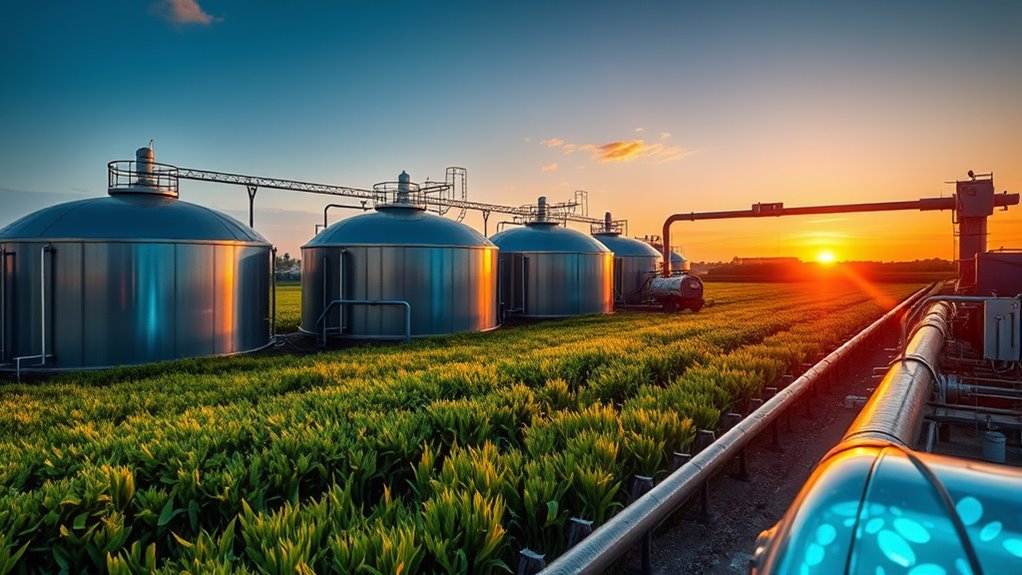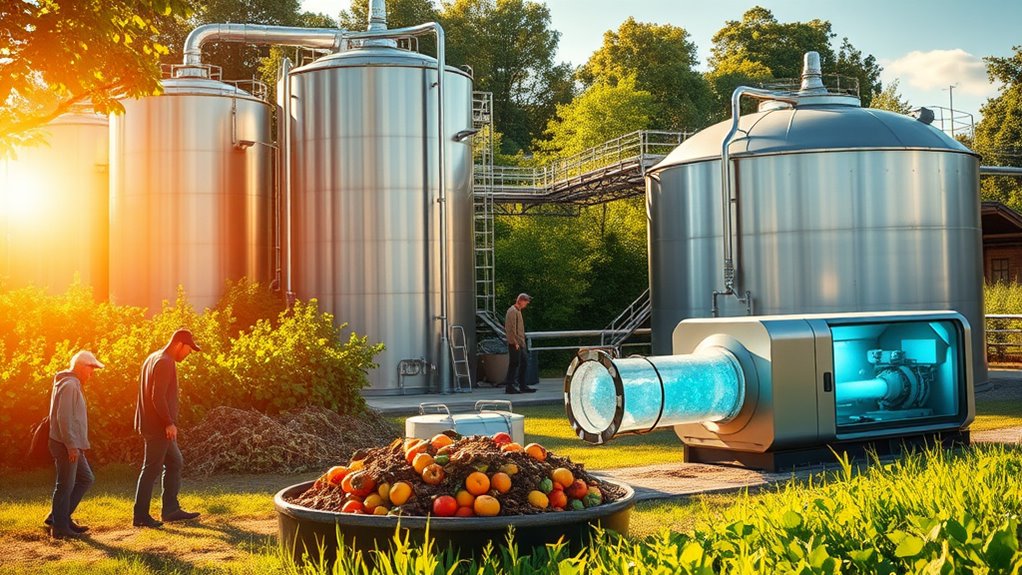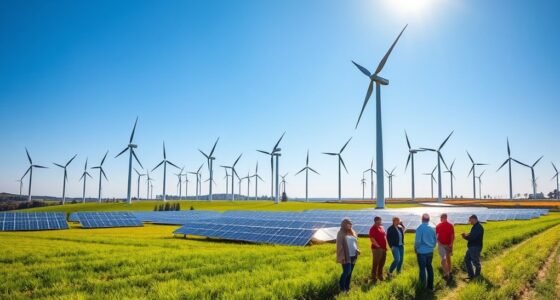Bioenergy and biogas turn your organic waste, like food scraps and manure, into renewable power through processes like anaerobic digestion. This method produces biogas, mainly methane, which you can use for electricity, heating, or fuel. By converting waste instead of sending it to landfills, you help reduce greenhouse gas emissions and pollution. If you’re interested, you’ll discover how these innovative technologies help create a cleaner, more sustainable future.
Key Takeaways
- Organic waste such as food scraps and manure can be transformed into biogas through anaerobic digestion.
- Biogas primarily consists of methane and carbon dioxide, which can be used for electricity, heat, or fuel.
- Converting waste into biogas reduces methane emissions from landfills and promotes renewable energy use.
- Biomass conversion technologies like gasification and pyrolysis produce versatile fuels from organic waste.
- Utilizing bioenergy from organic waste supports sustainable practices and decreases reliance on fossil fuels.

Have you ever wondered how renewable energy sources can help reduce reliance on fossil fuels? One powerful answer lies in bioenergy, especially through processes like anaerobic digestion and biomass conversion. These methods transform organic waste into valuable energy, providing sustainable alternatives that cut down greenhouse gas emissions and decrease our dependence on traditional fuels. When you think about organic waste—food scraps, manure, agricultural residues—you might not realize it holds immense potential. Instead of letting it decompose in landfills, producing methane and contributing to pollution, you can harness it for energy.
Organic waste like food scraps and manure can be transformed into clean, renewable energy through bioenergy processes.
Anaerobic digestion is a key process in this transformation. It involves breaking down organic material in the absence of oxygen, which produces biogas—mainly methane and carbon dioxide. This biogas can then be captured and used to generate electricity, heat, or even fuel for vehicles. It’s like turning waste into a power source, avoiding the release of potent greenhouse gases into the atmosphere. This process is not only efficient but also environmentally friendly, as it manages waste while producing clean energy. Additionally, the use of solar panels and other renewable technologies in conjunction with biogas systems can maximize energy production and efficiency.
Biomass conversion takes organic matter—whether it’s crop waste, forestry residues, or organic waste—and converts it into energy through various methods, including thermal, biological, or chemical processes. You might picture biomass as simply burning wood for heat, but modern biomass conversion technologies go far beyond that. They include advanced processes like gasification and pyrolysis, which produce synthetic gases or bio-oil from organic material. These fuels can then be used in power plants or for transportation, offering a renewable alternative to fossil fuels.
By integrating anaerobic digestion and biomass conversion into energy systems, you help create a circular economy. Organic waste no longer becomes a disposal problem; instead, it becomes a resource. This approach reduces landfill use, cuts methane emissions, and supplies clean energy to homes and industries. Plus, it encourages sustainable agriculture and waste management practices, fostering environmental stewardship.
In essence, these technologies empower you to contribute directly to a greener future. They demonstrate that with the right innovation, organic waste can be transformed into a reliable, renewable energy source. Whether through capturing biogas or converting biomass into usable fuels, you’re participating in a movement that replaces polluting fossil fuels with cleaner, sustainable alternatives. It’s a smart, practical way to turn everyday waste into power, helping to preserve the planet for future generations while meeting today’s energy needs.
Frequently Asked Questions
What Are the Environmental Impacts of Biogas Production?
You might wonder about the environmental impacts of biogas production. It can positively reduce greenhouse gases and waste, but it also has landscape implications, like land use changes. You should consider potential biodiversity effects, as large facilities may disrupt habitats or species. While biogas offers clean energy, you need to safeguard these benefits with environmental concerns to ensure sustainable implementation.
How Cost-Effective Is Setting up a Biogas Plant?
Imagine a farm with organic waste transforming into energy, showing how setting up a biogas plant can be quite cost-effective. You’ll need to conduct an economic analysis to understand the initial capital investment and ongoing costs. While upfront expenses can seem high, the long-term savings on energy bills and potential revenue make it a smart investment. With proper planning, you’ll find it both financially feasible and environmentally beneficial.
Can Biogas Replace Natural Gas Completely?
You might wonder if biogas can totally replace natural gas. While biogas scalability is improving, it currently can’t meet all natural gas demands due to limitations in production capacity and infrastructure. However, as a renewable energy source, biogas markedly contributes to reducing reliance on fossil fuels. Over time, technological advancements could make complete replacement more feasible, but for now, it’s a valuable supplement rather than a full substitute.
What Types of Organic Waste Are Suitable for Biogas?
You wonder which organic waste types are suitable for biogas, and the answer lies in feedstock diversity. You can use food scraps, agricultural residues, manure, and organic industrial waste. These waste types are rich in organic material and easy to break down. By choosing a variety of feedstocks, you increase biogas production efficiency. So, your options are broad, and diversifying organic waste types enhances biogas generation potential.
Are There Safety Risks Associated With Biogas Facilities?
When considering biogas plant safety, you should be aware of potential organic waste hazards. These hazards include the risk of explosions, fires, and the release of harmful gases like methane. Proper handling, regular maintenance, and safety protocols are essential to minimize risks. You must guarantee the facility is well-ventilated and that staff are trained. By doing so, you can reduce safety risks associated with biogas plant operations.
Conclusion
Think of bioenergy and biogas as the phoenix rising from the ashes of waste, transforming what once seemed useless into vibrant power. By embracing this alchemy, you become a steward of renewal, turning organic refuse into a renewable force that fuels our future. Like a gardener nurturing seeds into blossoms, your choices can cultivate sustainability. Together, you can ignite a cycle of growth, proving that from decay, new life and hope can always emerge.









